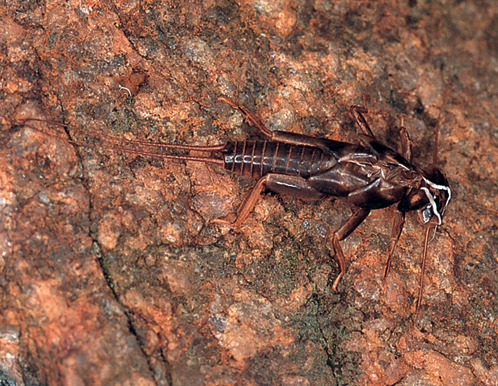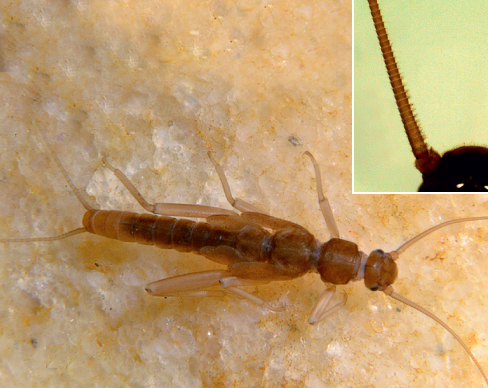
© C. GRIFFITHS & M. PICKER
10 |
Text by Duncan Stevens and Mike Picker |
|---|---|
Stoneflies
Order Plecoptera
Small to medium-sized (body length 4–25mm) soft-bodied insects with aquatic nymphs resembling adults in body form. Head broadly triangular, with large compound eyes and three ocelli (simple eyes). Thorax well developed and abdomen has 10 segments. Antennae long and threadlike. Abdomen of nymph terminates in two long, thin, multisegmented cerci (tactile appendages). Thoracic and abdominal gills may be present. Legs positioned so as to keep body flat against substrate. Wing pads visible in older nymphal stages. Adult body elongated, with two pairs of membranous wings, closely furled over or lying flat on abdomen. Cerci may be retained in the adult (Perlidae), or lost, except for the first segment (Notonemouridae). Nymphs are leaf shredders and detritivores, or carnivorous. Numerous nymphal instars; final instars have black wing pads and crawl out of the water onto a dry substrate leaving exoskeleton (shuck) (1) adhering to rocks. Adults sit exposed on rocks and vegetation at the steam edge under overcast conditions, or in cool crevices on undersides of rocks in hot weather. Poor fliers, but scurry rapidly over rocks when disturbed. Found mostly in clean fast-flowing mountain streams, and hence useful indicators of water quality. Of the 16 families and 2,000 species worldwide, only some 40 species in two families, Notonemouridae and Perlidae, occur in southern Africa.
True stoneflies
Family Perlidae

© C. GRIFFITHS & M. PICKER
Largest stoneflies in the region, with wings lying flat on abdomen. Adults easily distinguished from Notonemouridae (below) by presence of long multisegmented cerci that protrude from end of abdomen, and nymphs by presence of gills. Nymphs voracious predators on other aquatic insects, such as mayfly nymphs. Inhabit fast-flowing mountain streams with rocky beds, but also occur in slower, less well-oxygenated rivers, which they can probably tolerate because they possess gills. Only one genus in southern Africa.
2 Tropical stoneflies
Neoperla species


© C. GRIFFITHS & M. PICKER

© C. GRIFFITHS & M. PICKER

© C. GRIFFITHS & M. PICKER
Adults (2) yellow to tan, with prominent compound eyes and long cerci visibly protruding behind wings. Nymphs (2a) have gills on sides of body behind each thoracic segment, at base of each leg, and at end of abdomen (2b). Femora and tibiae bear a row of long fine hairs. Size: Body 25mm in length. Biology: Adults scuttle rapidly and are attracted to light. Mating occurs during the day, and females develop prominent egg ball at tip of abdomen. Genus comprises numerous similar species and has an Afrotropical distribution. Nymphs and adults found throughout the year.
Southern stoneflies
Family Notonemouridae
Small, thin and elongated grey or brown stoneflies (body 4–10mm in length; females larger than males), with wings closely furled around abdomen. In some species, short-winged or wingless individuals may occur. Adult cerci short, each comprising a single segment. Species identified by microscopic examination of adult genitalia. Adults may feed on algae, lichen and plant material. Nymphs brown, gills absent, cerci long and threadlike. Nymphs found under submerged rocks and leaf packs, and feed on decomposing leaves and periphyton. When disturbed, nymphs wiggle slowly and sluggishly along the stone, in contrast to mayfly nymphs, which wiggle rapidly and energetically. Adults live a few days. Six genera and 31 species occur in cold fast-flowing mountain streams throughout South Africa and Lesotho; most diverse in the Western Cape.
3 Cape stoneflies
Aphanicerca species


© C. GRIFFITHS & M. PICKER (BOTH)

© C. GRIFFITHS & M. PICKER
Nymphs (3) have enlarged antennal hairs on inside of lower parts of antennae (3a); compound eyes very small; body almost free of long hairs. Adults (inset) easily recognised, as they are the only stoneflies in the Western Cape with an obvious clear patch in the middle of the wings. Males have large two-pronged structure on top of end of abdomen, here concealed by wings. Size: Body 5–10mm in length. Biology: Restricted to Cape Fold Mountains. Eight described species, most with very restricted ranges. The Common Cape stonefly (A. capensis) occurs on Table Mountain. Adults have a winter emergence pattern.
4 Porcupine stoneflies
Desmonemoura species


© C. GRIFFITHS & M. PICKER

© C. GRIFFITHS & M. PICKER
Nymphs (4) appear smooth, with a few short abdominal bristles; compound eyes large; wing pads in older nymphs conspicuously banded; nymphs occasionally have slightly longer hairs on inner side of first few antennal segments. Adults (4a) yellow-brown, with characteristically banded wings; males have very long extensions at end of abdomen, concealed under wings here (including long, but still single-segmented, cerci), although shorter in D. brevis than D. pulchellum. Size: Body 4.5–8mm in length. Biology: Adults found in summer.
1 Hardy stoneflies
Aphanicercella species


© C. GRIFFITHS & M. PICKER
Nymphs (1) have incomplete whorls of hairs on abdominal segments – hairs on top of abdomen situated in middle and not extending to sides, with exceptions of segments 8–10, where whorls are complete. Males have short arm-like claspers at end of abdomen. Size: Body 4–6mm in length. Biology: Have the widest distribution range of all genera, having adapted to multiple habitat types; A. cassida is particularly widespread. Most of the 11 species occur in the Western Cape and have a winter emergence pattern.
2 Denticulate stoneflies
Aphanicercopsis species


© C. GRIFFITHS & M. PICKER
In nymphs (2) first thoracic segment is more circular than in nymphs of other genera; compound eyes small; body segments have a few short bristles. Adults difficult to distinguish from Aphanicercella in the field, except for slightly broader-looking middle segment of thorax at area of forewing attachment; short-winged and wingless individuals occur, the latter smaller in size than winged individuals. Males have clearly toothed reproductive structure at end of abdomen. Size: Body 3–6mm in length. Biology: Restricted to Cape Fold Mountains, with four known species, two of which occur on Table Mountain, A. tabularis being the more abundant. Adults emerge in wet winter months, mainly May–August.
3 Tufted-nymph stoneflies
Afronemoura species


© C. GRIFFITHS & M. PICKER (BOTH)

© D. STEVENS & M. PICKER
Nymphs (3) readily recognised by conspicuous tuft of coarse hairs situated a third of the way up the antennae (inset); abdominal segments bear few short bristles. Males bear one or two small dark spines on last part of abdomen. Size: Body 4.5–8.5mm in length. Biology: Three species; the two most common, A. amatolae and A. spinulata (3a), occur in the Hogsback and Amatola mountains of the Eastern Cape and in the Mpumalanga Drakensberg. The genus also occurs in the KwaZulu-Natal Midlands. Adults occur throughout most of the year, but more common May–December.
4 Drakensberg stoneflies
Balinskycercella species


© C. GRIFFITHS & M. PICKER

© C. GRIFFITHS & M. PICKER
Nymphs (4) hairy, with complete whorls of long hairs on all abdominal segments, except under abdomen in midline; wing pads evenly covered in long bristles. Males have one or two recurved hooks on end of abdomen. Balinskycercella tugelae (4a) has clear patch on forewings as in Aphanicerca (see p.168, 3), but the two genera are geographically separate. Size: Body 4–8.5mm in length. Biology: Three species, all restricted to KwaZulu-Natal Drakensberg and Lesotho. Adults found in summer, the main emergence period being November–January.